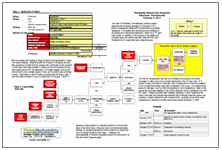The town of Allentown, Pennsylvania suffered severe physical and emotional damage on February 9, 2011, when 5 people were killed and 8 homes were completely destroyed. The deaths and destruction were believed to be caused by a natural gas explosion, fueled by a 12″ gas main break. In addition to the impacts to the safety and property goals, the natural gas leak, extended fire, and time/labor by 53 responders also impacted goals.
We can analyze the causes of these impacts to the goals with a visual root cause analysis. Beginning with the impacts to the goals, we ask why questions to determine the causes that contributed to the incidents. In this case, there was a delay in putting out the fire because the fire had a heat source from the explosion, a constant oxygen source (the environment) and a steady supply of fuel, as the natural gas continued to leak. There was no shut-off valve to quickly stop the flow of gas. It took the utility company 5 hours to finally turn off the gas. It took 12 more hours before the fire was completely put out.
 The fuel for the explosion and the fire is believed (according to the utility company) to have come from a break discovered in the 12″ gas main. A 4′ section of pipe, removed on February 14th, is being sent for a forensic analysis to aid in determining what may have contributed to the crack. It’s possible there was prior damage – such as that from weather or prior excavations. Most of the pipe in the area was installed in the 1950s, although some is believed to be from the 1920s. Budget shortfalls have delayed replacing, or even inspecting the lines in the area, and officials have warned that continuing financial issues may continue to delay inspections and improvements, causing concern with many residents, who suffered a similar natural gas pipeline explosion in 1994.
The fuel for the explosion and the fire is believed (according to the utility company) to have come from a break discovered in the 12″ gas main. A 4′ section of pipe, removed on February 14th, is being sent for a forensic analysis to aid in determining what may have contributed to the crack. It’s possible there was prior damage – such as that from weather or prior excavations. Most of the pipe in the area was installed in the 1950s, although some is believed to be from the 1920s. Budget shortfalls have delayed replacing, or even inspecting the lines in the area, and officials have warned that continuing financial issues may continue to delay inspections and improvements, causing concern with many residents, who suffered a similar natural gas pipeline explosion in 1994.
Because implementation of potential solutions to improve the state of the utility lines in the area may be limited by available funding, it’s unclear what will be done to attempt to reduce the risk of a similar incident in the future. However, the unacceptability of resident casualties should stir some action so that this doesn’t happen again.
